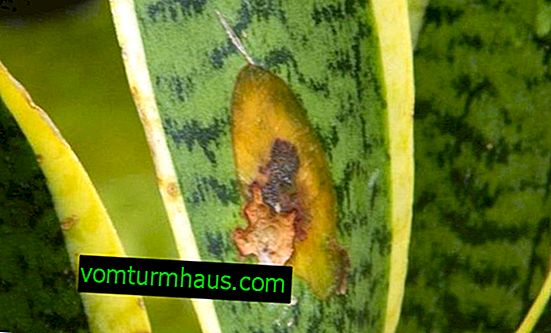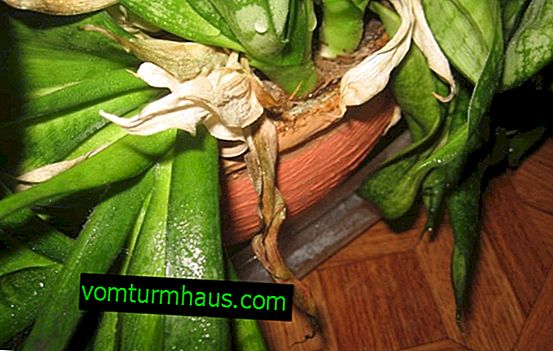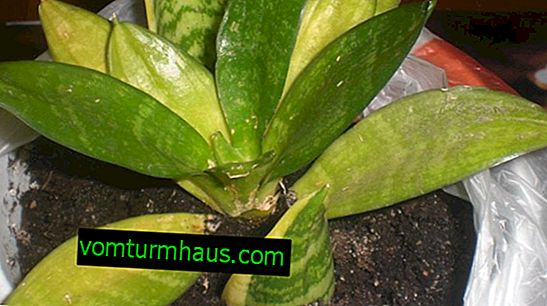Sansevieria three-way: home care
Many lovers of indoor plants want to have a flower that not only decorates the room, but also benefits. We offer you to pay your attention to the three-lane sansevieria - it is famous for its beautiful patterned foliage, and also perfectly cleans the air. Let's get to know this plant better.
Botanical description of the plant
Sansevieria (other common names - mother-in-law tongue, pike tail, devil tongue, snake skin) is an evergreen stemless perennial native to the tropics and subtropics. Its height reaches 120 cm. The root system of the plant is fibrous and at the same time compact in size. Leaves of dense structure and oblong form grow immediately from the roots, most often vertically or with a slight bias to the sides. They can be either long or short.
The edges of the leaves are solid, with a dense surface, which helps the flower to avoid strong evaporation of moisture. The plate is painted in saturated green color, which is diluted with a border of yellow or silver color, as well as a pattern of transverse stripes throughout the sheet. Each year, with proper care, 3 young leaves are formed in the outlet.

Flowering occurs in the warm season. A flower stalk is formed in the center of the leaf, on which a large number of small star-shaped flowers are located. The buds exude a pleasant aroma that resembles vanilla or cloves. On average, sansevieria blooms 2 weeks. After flowering is complete, the plant ceases to form new leaves.
Conditions for successful growing at home
The pike tail is a generally unpretentious plant that can survive in various conditions. However, a lack of light, temperature changes and a long absence of moisture can negatively affect its condition. Consider what indicators need to be observed for the full growth of the flower.
Location and Lighting
In order for the leaves of sansevieria to grow well and be powerful at the same time, the flower must receive enough sunlight, which, in addition, will add shine to the leaves. The ideal place for the plant is the windowsills of the eastern and western windows. The south window is also suitable, but in the hot season you need to shade the foliage from the scorching sun.
Important! If you obscure sansevieria too much, this will lead to a slowdown in its growth and the disappearance of a light pattern on the leaves.
Temperature and humidity
Sansevieria is a thermophilic flower. In daylight, the optimum temperature for this plant is + 21 ... + 28 ° C. Suitable night temperature is + 16 ... + 20 ° С.
Teschin tongue adjusts to the usual humidity in the room, and additional actions aimed at increasing the level are not required. To improve the appearance of the flower, it is recommended to regularly wipe the leaves from dust. It is important that the water is soft, otherwise white stains will appear on the foliage.

Home Care
Caring for sansevieria is no different from caring for other indoor plants. As usual, this is watering, top dressing, pruning and transplanting. Consider how they should be done correctly.
Watering
The pike tail is a succulent and therefore negatively reacts to soil overmoistening. Watering should be negligible, moisten the soil only after its visible drying. The optimum water temperature is room temperature. You need to use melt or standing water. During watering, it is important to ensure that the liquid does not get into the base of the leaves, since in this case there is a high probability that the flower will begin to rot.
Did you know? In Germany, sansevieria is called "African hemp, " because Africans extract fibers from its leaves for fabrics and ropes.
Top dressing
To improve plant growth, you can use the following types of fertilizers:
- designed for cacti and succulents;
- complex compositions for indoor crops.

Pruning
The pruning procedure is to remove old leaves, the presence of which leads to the loss of the decorative appearance of the flower. Such manipulations allow young shoots to develop better and faster. Among other things, they trim the dried ends of the leaves. However, it is important to remember that removing too many leaves can cause a slowdown in flower growth.
We recommend that you familiarize yourself with other varieties of succulents:
Transfer
Sansevieria should be transplanted as needed, when the roots of the plant no longer fit in the pot and peek out of it.
A young flower should be replanted every 1.5 years, and then - once every 3 years. When the plant reaches a large size, it is placed in a box or tub and there is no possibility to transplant it; it is enough to change the top layer of the substrate.
Teschin tongue feels good in light soil, which easily passes moisture.

You can independently prepare the soil mixture from the following parts:
- turf land - 2;
- sheet land - 1;
- sand - 1;
- humus - 1;
- peat - 1.
The transplant procedure is as follows:
- The plant must be removed from the old pot, the roots completely rid of the old earth, to check for rot or various injuries on them.
- To put expanded clay at the bottom of a new pot, and on top - prepared soil, leaving a small distance to the edges of the tank.
- In the middle of the pot, plant a plant, slightly pressing down the roots and covering them with soil.
- Moisten the earth and put the pot in the selected place.
Video: Three-way Sansevieria transplant
Breeding
To increase the number of these plants at no extra cost, it is recommended to use one of the methods described below.
Rhizome division
Reproduction of sansevieria by division of the rhizome is best done during the spring transplant. For separation, you need to use a sharp knife, and for processing fresh slices - crushed coal. For breeding, a lateral branch is used, which is connected to the mother bush with strong rhizomes. It is they who are being cut.
After processing the slices, a young bush needs to be planted in a new pot. At first, the care of a new flower consists in a small watering, and fertilizers can be applied only after a month.

Cuttings
Propagation by cuttings is a rather long process. Most often it is used when at one time they want to get a lot of new plants at once.
Important! For variegated species of sansevieria, the method of propagation by cuttings is not suitable, since the color of the leaves is not transmitted. Such species are propagated exclusively by rhizome division.
Adult lower leaves are suitable for this procedure. It is important that they are healthy. Leaves need to be cut and slightly dried, leaving them in the air for 2 days. Then cut them into pieces, each size from 5 to 10 cm. Rooting is carried out in a moistened substrate. Sand, peat or vermiculite is suitable for this. Leaflets need to be placed vertically in the substrate, deepening one edge by 2 cm and at the same time slightly compacting the soil around. The distance between them should be about 3 cm.
Rooting requires a lot of light, heat and humidity. The container must be covered with polyethylene to create the effect of a greenhouse. To root faster, it is necessary to carry out ventilation daily and, if necessary, to moisten the soil. The first roots appear after 21 days, however, transplantation into separate containers should be done no earlier than 2 months later.

Growing difficulties
Despite the fact that growing sansevieria at home practically does not cause problems, the plant is still subject to a number of ailments.
Consider how they manifest and how to deal with them:
- Dark spots on the leaves . To eliminate them, you need to reduce the amount of water and increase the temperature in the room.

- Yellowing foliage . Move the pot to a lighter place and transplant the plant into a larger container.

- Softening and deviation of leaves . Change pot location.

- Yellowing foliage near the roots . Transplant a flower with mandatory disinfection of the roots.

- Lethargy . Check if watering is carried out correctly.

- Yellowing leaf tips . Reposition pot and reduce moisture.

As can be seen from the foregoing, caring for sansevieria at home will not cause any difficulties. The main thing is to adhere to the rules set forth, and then the plant will delight for a long time with its original foliage.









